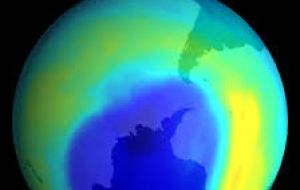MercoPress. South Atlantic News Agency
NASA study finds close links between climate and the ozone hole size variation
 “Ozone holes with smaller areas and larger total amount of ozone are not necessarily evidence of recovery attributable to the expected chlorine decline”
“Ozone holes with smaller areas and larger total amount of ozone are not necessarily evidence of recovery attributable to the expected chlorine decline” It turns out that the ozone hole may not be completely healed--at least according to new NASA data. Scientists have examined the inner workings of the ozone hole that forms annually over Antarctica and have found that declining chlorine in the stratosphere has not yet caused a recovery of the ozone hole.
About 20 years ago, officials created the Montreal Protocol agreement; this agreement limited human emissions of ozone-depleting substances. Since then, satellites have monitored the area of the annual ozone hole and have watched it stabilize, ceasing its growth. However, it seems that recovery is not yet present and that temperature and winds are still driving any annual changes in ozone hole size.
“Ozone holes with smaller areas and larger total amount of ozone are not necessarily evidence of recovery attributable to the expected chlorine decline,” said Susan Strahan, one of the researchers in a news release. “That assumption is like trying to understand what's wrong with your car's engine without lifting the hood.”
In order to learn a bit more about the ozone hold, the researchers used satellite data to peer inside it. More specifically, they tackled the 2012 ozone hole, which is the second-smallest hole since the 1980s. In order to find out what caused this hole's diminutive area, the researchers used data to create a map that showed how the amount of ozone differed with altitude throughout the stratosphere in the center of the hole during the 2012 season.
So what did they find? The class metrics create the impression that the ozone hole has improved as a result of the Montreal protocol. In reality, though, meteorology was responsible for the increased ozone and resulting smaller hole, as ozone-depleting substances that year were still elevated. It's these weather conditions in particular that reveal that the climate has more to do with the ozone hole than the actual ozone-depleting gases.
In fact, this work shows that the severity of the ozone hole as measured by the classical total column measurements does not reveal the significant year-to-year variations in the two factors that control ozone: the winds that bring ozone to the Antarctic and the chemical loss due to chlorine.
“We are still in the period where small changes in chlorine do not affect the area of the ozone hole, which is why it's too soon to say the ozone hole is recovering,” said Strahan in the news release “We're going into a period or large variability and there will be bumps in the road before we can identify a clear recovery”




Top Comments
Disclaimer & comment rules-

Read all commentsSo yet again the doomsayers of the “global warming brigade” OH NO, it's “climate change” now and I wonder when it will be “We haven't got a fucking clue brigade” due to them being incorrect so many times, have got the model wrong.
Dec 13th, 2013 - 03:36 pm 0Who would have thought that? Ha, ha, ha.
It’s pesky Mother Nature and all the winds she produces that is driving the numbers.
Ah well, at least she knows what she is doing.
Commenting for this story is now closed.
If you have a Facebook account, become a fan and comment on our Facebook Page!